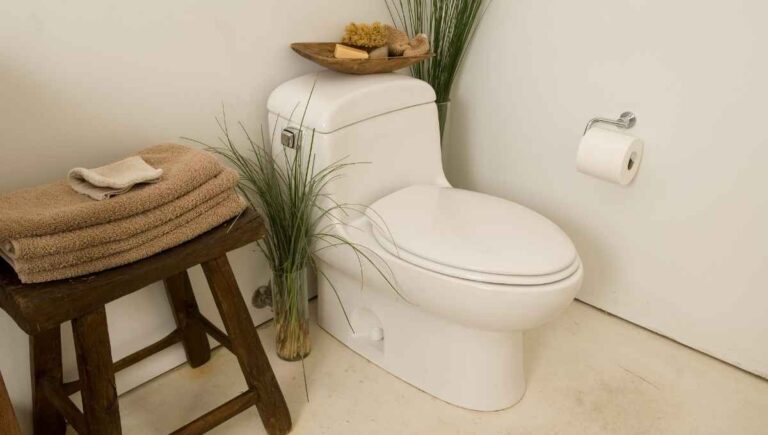Do Bathtubs Have a Weight Limit? (What You Should Check For)

Knowing the weight limit of your bathtub can help you avoid unwanted bathroom disasters. The last thing you want is to mess things up and have your bathtub crack, or worse, destroy the floor underneath it! So before you dive into your bathtub renovation project, you need to know if bathtubs have a weight limit.
On average, most bathtubs can hold anywhere between 350 to 1000 pounds. While all bathtubs do have a weight limit, the exact weight limit can vary significantly depending on the material used, the size of the tub, the thickness of the floor, and the placement of the tub.
Unfortunately, it’s not easy to determine the weight limit for a bathtub. But, since the consequences can be severe, it’s best to do your research in advance to make sure the particular bathtub you’re looking at will work.
Still, there are guidelines you can follow to assess the weight limit of your bathtub, prevent breakage, and make sure your floor will support your bathtub. Keep reading to learn it all!
This post contains affiliate links. This means Household Blogger may earn a commission should you make a purchase using any of our links. Please refer to our full affiliate disclosure policy for full details.
Here’s a Quick Pro Tip!
The weight limit of your bathtub may vary, but your need for a stable bathtub won’t. Once you pick the bathtub material and size that’s right for you, you’ll want to make sure you install it securely.
Here are some of the best things to help you stabilize and install your bathtub:
1. Shoulder Dolly Moving Straps-First things first: you need to carry that tub inside!
2. Great Stuff Big Gap Filler– Keep your pre-installed bathtub in place with this gap filler.
3. SimpleSet Pre-Mixed Thin-Set Mortar – Every bathtub needs a mortar bed to stay stable!
Basics of Bathtub Weight Limits
Every bathtub has a different weight limit depending on its material and configuration. It’s important to research what each bathtub weight limit is really like in order to prevent tub and home damage.
Is There a Weight Limit For Bathtubs?
Bathtubs will always have a weight limit of some sort. The exact number will be different for each bathtub, based on a variety of factors about how the bathtub is constructed, its size, and where in the house it is placed.
Bathtubs usually will specify how many gallons of water they can hold. Since the weight of water is consistent, it’s safe to say that a bathtub will be able to hold that much weight.
For example, most standard bathtubs in the US will hold 60 gallons of water or 501 pounds.
This is different from the weight limit for the floor, which you need to find out before you install a bathtub. Having your floor cave-in will be a much bigger problem than your bathtub cracking!
Can a Bathtub Break?
Bathtubs are sturdy fixtures, but they can crack and break. The main cause for breakage is physical trauma, such as dropping heavy objects or bashing things into the sides of a tub.
The small dents and cracks caused by physical trauma can break the bathtub entirely if left unfixed.
Although weight limits and overfilling are rarely the cause of a bathtub breaking completely, it does depend on how regularly you exceed the tub’s weight limits and the type of material the tub is made out of.
Fiberglass is one of the weakest materials for a bathtub, and it can become brittle and crack from use over time.
If you’re a heavy person with heavy bathtub usage, fiberglass tubs probably aren’t for you!
How Much Weight Can The Average Bathtub Hold?
The average bathtub in the US will usually hold around 60 gallons of water or 501 pounds. Many standard bathtub sizes in the US hold up to 80 gallons of water, which translates to 668 pounds.
That being said, you shouldn’t go off of a simple average when you’re trying to do bathtub renovations.
Checking the actual weight limit of the bathtub you have in mind will save you from a world of trouble later on.
If you don’t know the type of bathtub you have, you can check guides to identify the material and measure the tub with a tape measure to get a good idea of how much water weight it can hold.
You might also enjoy our post on How Much It Costs to Fix a Cracked Bathtub
How Much Weight Can an Acrylic Bathtub Hold?
Acrylic alcove bathtubs usually weigh between 80-100 pounds on their own. The weight limit for this type of tub is usually in the range of 333-667 pounds when including water and a person.
Although alcove bathtubs are the most common in the US, the precise weight limit will vary depending on the size and type of bathtub.
As frustrating as it is to see a range that wide, the reality is that acrylic bathtubs come in all shapes and sizes.
Acrylic tends to be lighter weight than some other bathtub materials, but it all comes down to the specific bathtub.
Alcove bathtubs also tend to be one of the lightest bathtub configurations. If your bathtub isn’t an acrylic alcove, you can expect the weight limit to be on the higher end of the spectrum.
How Much Weight Can a Porcelain Bathtub Hold?
Porcelain bathtubs can weigh anywhere between 250 to 320 pounds by themselves. These tubs generally have a water capacity of 40-60 gallons and a corresponding weight limit of 335-500 pounds.
The exact weight limit isn’t the same for every porcelain bathtub, and it’s possible for some porcelain tubs to go outside of these ranges.
Porcelain is a beautiful but heavy material, which contributes to this type of tub weighing more than most plastics and acrylics.
To be safe, you should make sure that you check the specifications of the bathtub you’re planning on using before you install it or take a bath in it.
How Much Weight Can a Plastic Bathtub Hold?
Plastic bathtubs, also known as acrylic bathtubs, can hold around 40-80 gallons or 333-667 pounds worth of water. The more common kinds of acrylic bathtubs are usually on the lower side of that spectrum, but some acrylic bathtubs can hold up to 1000 gallons.
Acrylic is the main kind of plastic that is used in bathtubs, which happens to be the lightest bathtub material in common use.
Despite how light the tub itself is, acrylic bathtubs can hold plenty of water!
In all likelihood, you won’t exceed the weight limits of a large acrylic tub.
If you have a high body weight and you’re using a smaller acrylic bathtub, be sure to look into the weight capacity of that tub before use.
How Much Weight Can a Fiberglass Bathtub Hold?
A fiberglass bathtub that can hold 54 gallons will have a weight limit of around 450 pounds. Fiberglass is a relatively brittle material compared to other bathtub materials, so its weight limit should be treated as lower than other bathtubs even if the tub is the same size.
Fiberglass is lightweight, but it’s also both an expensive and delicate material. You need to be extra careful not to exceed the weight limit if you have this kind of tub.
Even from normal use within the weight limit, it’s possible for your fiberglass tub to experience more cracking over time than other tubs.
What Is The Heaviest Type Of Bathtub?
The heaviest type of bathtub is a walk-in bathtub, and the heaviest material for bathtubs is cast iron. Cast iron is a thick metal, which is bound to weigh more than plastics, fiberglass, steel, and porcelain. Many cast iron bathtubs are between 300-and 500 pounds.
If you need a lighter bathtub, it’s best to go with acrylic (plastic), stainless steel, or fiberglass. The size of a bathtub also plays a crucial role in the weight of the tub.
You might not need to give up on a cast iron bathtub for weight reasons if you can settle for a smaller version.
No matter what material is used, the style and size will dictate what the total weight of your bathtub is.
You might also enjoy our post on If a Toilet Can Fall Through the Floor
How Much Do Steel Bathtubs Weigh?
Steel bathtubs weigh around 75 pounds on average, but it depends on the size of the bathtub. This is only slightly heavier than the lightest bathtub materials such as acrylic and fiberglass, and significantly lighter than cast iron tubs.
Stainless steel is a great material to use for a bathtub. Since the steel is usually coated with porcelain enamel, they have the same pretty look as your typical porcelain bathtub.
On top of that, steel bathtubs tend to be light and durable. They aren’t quite as strong as a cast iron tub, but they’re certainly cheaper!
What Is The Lightest Tub?
Alcove bathtubs are the lightest configuration of bathtubs since they rely partially on the surrounding walls. As for materials, acrylic plastic bathtubs are the lightest. Often, these tubs are only 60-70 pounds on their own.
Fiberglass and stainless steel enameled tubs are two other light options.
Although the weight of the bathtub is important, the size is actually more relevant. Smaller tubs will always be lighter than larger ones, and this is especially true when water weight is factored in.
If you’re looking for a bathtub that won’t damage the flooring, then make sure the weight limit of the tub (including water and human weight) isn’t too high.
Finding The Best Tub For You
The danger of floors caving in aside, people with special requirements for their bathtubs need to pay attention to the weight limits and materials used.
There are even special tubs to be purchased for people who are heavier than average or who have health needs.
What Is The Best Tub For a Heavy Person?
Walk-in bariatric bathtubs are the best and the safest option for heavy people, obese people, seniors, and anyone who has limited mobility or lightheadedness in the shower.
These tubs eliminate the need to stand up while bathing, step over a high wall, or get up from the bathtub basin.
Bariatric tubs are commonly used in senior homes, but they work for anyone who has limited mobility or health issues no matter the age.
As the name implies, walk-in tubs have small gateways on the side of the tub that let the user step in rather than climb in.
Many of them also come with a seat so that the user can sit down while washing themselves.
For bathtubs that don’t have a built-in seat, medical sliding transfer benches can be purchased individually and added to the tub.
What Is The Weight Limit For a Walk-In Tub?
Regular walk-in tubs are built to hold people that are 300 pounds or lighter. Bariatric walk-in tubs, on the other hand, have an upper weight limit of 600+ which allows them to service significantly heavier bathers.
Bariatric walk-in tubs are especially good for large and/or heavy people because they tend to be larger on average than other bathtubs. Similarly, their weight limit is also higher than other tubs.
Regular walk-in tubs are usually cheaper than bariatric ones and can still hold heavy people so long as they’re under 300 pounds.
Whether or not you need a full bariatric tub will really depend on your individual needs.
Installing a Bathtub In Your Bathroom
No bathroom is complete without a bathtub- unless it’s a half-bath, of course.
When renovating or adding a bathtub to your bathroom, you need to be sure that the bathtub will be a safe and functional installation.
Can a Bathtub Be Too Heavy?
Bathtubs can be too heavy for the floor if the floor isn’t thick enough or doesn’t have the appropriate support. Bathtubs are one of the heaviest things in a home, so specialty bathtubs (like bariatric walk-in tubs) can tip the scales and make the bathtub too heavy to install.
Most normal bathtubs (think in a weight range of 500-800 pounds when full of water and with a person in them) are perfectly fine to install in a bathroom.
Bathroom floors are made to hold a lot of weight, so even up to 800 pounds shouldn’t be an issue.
This means that cast iron bathtubs are perfectly fine and won’t cause damage to the typical bathroom floor.
That being said, bathtubs that are 1,000+ pounds could potentially be too heavy for the floor.
How Much Weight Can a Bathroom Hold?
Bathroom floors are generally made to hold at least 2,000-2,200 pounds in the US. This includes bathtubs, showers, sinks, toilets, and any other object that is inside the bathroom.
This number will be smaller for smaller bathrooms and larger for larger bathrooms.
Many countries (including the US) standardize the weight limit for floors in homes.
In America, the standard is 40 pounds/sqft, which sets most bathrooms at around 2,000 pounds of weight capacity.
This is more than enough for most bathroom fixtures, but if you’re planning on adding something especially large or heavy, it’s best to check exactly what the weight limit for the floor is.
You might also enjoy our post on How Much it Costs to Move a Toilet
Can a Bathtub Fall Through The Ceiling?
Heavy bathtubs and water damage can result in the tub damaging the floor underneath it. It’s unlikely that it would fall straight through the ceiling since homes in the US have a subfloor with joists that would prevent this from happening.
In theory, it is possible for a bathtub to fall through the ceiling if the tub is too heavy or with significant water damage.
Unless you really, really mess up your home renovation project (i.e., you cut the joists or destroy them in some other way), a bathtub won’t literally fall through the ceiling.
What could happen is that the bathtub may damage the floor around it.
In very extreme cases, the bathtub could fall to the subfloor if enough damage was done over time.
This wouldn’t happen suddenly or without warning, though, and you’d be able to clearly see the floor sagging and other destruction happening to the home framing.
Can My Floor Support a Bathtub?
Your bathroom floor will be able to support a typical bathtub in most cases. So long as the home is made using the typical US standard of 40 lbs/sqft and the bathtub is not exceptional in any way, your floor will be stable and strong enough to hold up one bathtub plus other regular bathroom amenities.
Since floors in the US are generally made to hold up to 40 pounds of weight per square foot, many bathrooms can hold a total weight capacity of 2,000-2,200 pounds.
This is more than enough to hold a bathtub filled with water and with a person inside it.
If the joists on the floor are damaged or if your bathtub is especially heavy for some reason, you could have issues.
Chances are, you’ll be totally fine otherwise!
Can My Second Floor Support a Bathtub?
In most cases, second floors are just as capable of supporting a bathtub as the first floor. The main difference is that floor/ceiling damage could be more difficult to remedy if it does occur.
Still, it’s unlikely that it will happen as most homes in the US are standardized to be able to hold a minimum of 40 lbs/sqft.
That standard of 40 lbs/sqft usually allows most US bathrooms to hold 2,000-2,200 pounds total. You do need to consider the typical amenities that are in a bathroom, but a regular bathtub should easily be supported.
The only reason you might have issues is if the joists under the tub are damaged in some way. If you are looking at an especially heavy bathtub, you might want to check to make sure the floor and joists are secure.
What Is Underneath a Bathtub?
Structurally, bathtubs and showers usually have joists supporting them in the subfloors. Additionally, the vast majority of bathtubs and showers are built on top of a mortar base which helps with security and stability.
The joists in the subfloors are what allow heavy amenities, like bathtubs, to stay supported even on the second floor.
Combined with the mortar base, tubs are made as waterproof and safe as possible.
These foundations are what allow you to take as many warm baths as you want, without having to worry about catastrophic consequences!
How Can I Be Sure My Floor Can Support My Bathtub?
Most floors in the US are built to support 2,000-2,200 pounds of weight. This is more than enough to support a typical bathtub, but if you’re concerned about your floor’s ability to hold up a tub then you should ask a professional to appraise the floor.
Some floors could be weaker than the standard, especially if the house is old or if you’re building it yourself.
As you might expect, some specialty bathtubs might also warrant checking the stability of your floor. The weight of a walk-in bariatric tub, for example, can really add up.
You’ll need to factor in the weight of the water and the person on top of everything else!
Related Questions
How Heavy Is a Bathtub Full Of Water?
The weight of a bathtub full of water depends on the size of the bathtub and the material the bathtub is made of. In the USA, most bathtubs hold between 60 and 80 gallons of water. That much water will weigh between 501 and 668 pounds.
Keep in mind that you won’t be filling your bathtub to capacity every time you take a bath. There wouldn’t be any room for an actual person!
It’s safe to assume that the actual weight of a “full” tub of water will be less than the maximum water capacity.
How Do You Stabilize a Bathtub?
Bathtubs are stabilized first during construction by setting a mortar or mud bed. This can only be done before installation. To stabilize post-installation, you can use a foam spray or expanding foam to help support the tub.
Particularly for fiberglass tubs, a mortar bed is a necessity. Fiberglass tends to be the most brittle and delicate out of all the bathtub materials.
But really, all bathtubs should be built on a mortar bed for stability!
Final Thoughts
For most bathtubs, you really don’t need to worry much about the weight of a bathtub. Plus, even specialty bathtubs will tell you in their specifications what their weight limit is.
Barring the extreme, bathtub weight limits shouldn’t get in your way, so get out there and finish designing your dream bathroom!










